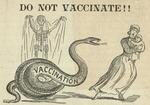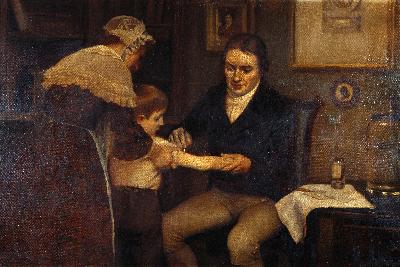Cartoon from an anti-vaccination publication, titled 'Do not vaccinate!'
Production date
1892
See full details
Details
Description
Cartoon, held by The Historical Medical Library of The College of Physicians of Philadelphia
History
Resistance to and misinformation about vaccines have been around for as long as vaccinations have existed. During the 1850s, the government passed a series of laws that made vaccination against smallpox compulsory for children. While some people supported vaccination, others thought it was unsafe or unnecessary and saw it as government interference. Some were suspicious of using material from cows to cure human disease. During the 1890s, the National Anti-Vaccination League organised protests and published anti-vaccine propaganda.
Although the smallpox vaccine continued to be effective, the government made it possible for parents to get a certificate of exemption in 1898. Compulsory vaccination for smallpox in the UK ended in 1948.
Was the smallpox vaccine a success story?
Despite some opposition, vaccination soon became standard practice for preventing smallpox. Thanks to a global eradication programme of mass vaccination, the World Health Organisation officially declared smallpox eradicated in 1980. Smallpox remains the one human disease to have been eradicated through our intervention.
Why did people fear vaccination in the past?
Vaccination has come a long way since its initial discovery. It is much safer than it was during the 18th and 19th centuries. Today, we also have a lot more access to accurate information about vaccines, allowing us to separate myths from facts.
- See our Covid-19 FAQs: https://www.redcross.org.uk/get-help/coronavirus/coronavirus-vaccine/coronavirus-vaccine-faq
- See our education resources on managing worries and decision making: https://www.redcross.org.uk/get-help/coronavirus/coronavirus-vaccine/vaccine-voices/managing-worries-and-decision-making
Although the smallpox vaccine continued to be effective, the government made it possible for parents to get a certificate of exemption in 1898. Compulsory vaccination for smallpox in the UK ended in 1948.
Was the smallpox vaccine a success story?
Despite some opposition, vaccination soon became standard practice for preventing smallpox. Thanks to a global eradication programme of mass vaccination, the World Health Organisation officially declared smallpox eradicated in 1980. Smallpox remains the one human disease to have been eradicated through our intervention.
Why did people fear vaccination in the past?
Vaccination has come a long way since its initial discovery. It is much safer than it was during the 18th and 19th centuries. Today, we also have a lot more access to accurate information about vaccines, allowing us to separate myths from facts.
- See our Covid-19 FAQs: https://www.redcross.org.uk/get-help/coronavirus/coronavirus-vaccine/coronavirus-vaccine-faq
- See our education resources on managing worries and decision making: https://www.redcross.org.uk/get-help/coronavirus/coronavirus-vaccine/vaccine-voices/managing-worries-and-decision-making
Catalogue Number
150.35
Subject auto tags
Object Types
Part of 1 highlight set
Share
All images are the property of the British Red Cross Museum and Archives (unless otherwise indicated), and cannot be used without permission. For queries about permission to use images, please contact enquiry@redcross.org.uk.


